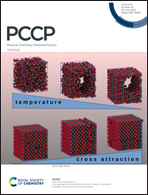New organic ionic plastic crystals utilizing the morpholinium cation†
Abstract
Organic ionic plastic crystals (OIPCs) are emerging candidates as safer, quasi solid-state ion conductors for various applications, especially for next-generation batteries. However, a fundamental understanding of these OIPC materials is required, particularly concerning how the choice of cation and anion can affect the electrolyte properties. Here, we report the synthesis and characterisation of a range of new morpholinium-based OIPCs and demonstrate the benefit of the ether functional group in the cation ring. Specifically, we investigate the 4-ethyl-4-methylmorpholinium [C2mmor]+ and 4-isopropyl-4-methylmorpholinium [C(i3)mmor]+ cations paired with bis(fluorosulfonyl)imide [FSI]− and bis(trifluoromethanesulfonyl)imide [TFSI]− anions. A fundamental study of the thermal behaviour and transport properties was performed using differential scanning calorimetry (DSC), thermal gravimetric analysis (TGA) and electrochemical impedance spectroscopy (EIS). The free volume within the salts has been investigated by positron annihilation lifetime spectroscopy (PALS) and the ion dynamics using solid-state nuclear magnetic resonance (NMR) analysis. Finally, the electrochemical stability window was studied using cyclic voltammetry (CV). Out of the four morpholinium salts, [C2mmor][FSI] exhibits the widest phase I range from 11 to 129 °C, which is advantageous for their application. [C(i3)mmor][FSI] displayed the highest conductivity of 1 × 10−6 S cm−1 at 30 °C, whereas the largest vacancy volume of 132 Å3 was found for [C2mmor][TFSI]. These insights into the properties of new morpholinium-based OIPCs will be important for developing new electrolytes with optimised thermal and transport properties for a range of clean energy applications.

- This article is part of the themed collection: Showcasing Physical Chemistry research in Australia and New Zealand


 Please wait while we load your content...
Please wait while we load your content...